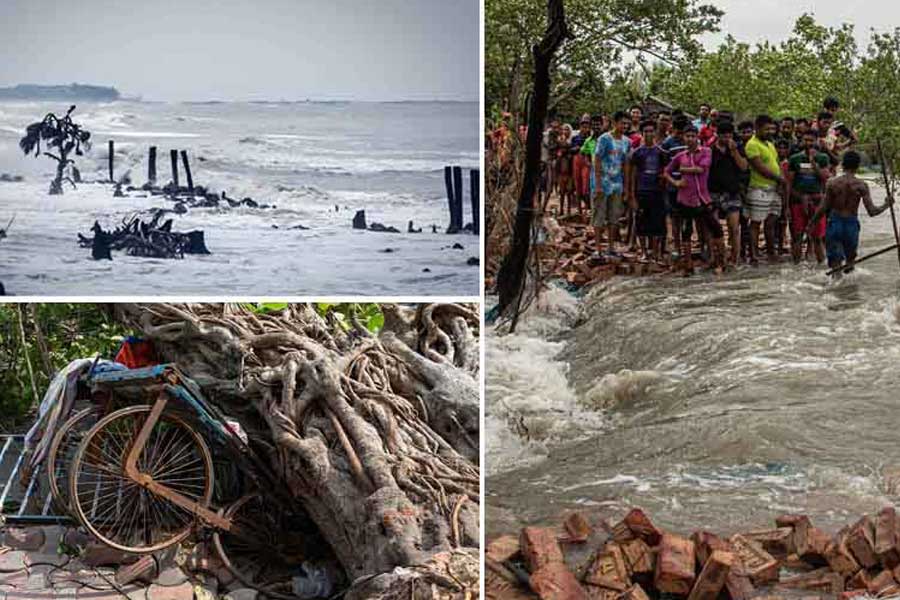The Sunderbans has been battered by a series of climate-triggered cyclones and other natural calamities since 2019 and this had led to financial loss in excess of Rs 1.5 lakh crore but the mangrove delta has hardly received any significant support from the banking sectors.
In 2022, extreme natural calamities impacted India on 314 out of 365 days but major banks of India have been found to be unprepared to confront climate risks, according to new analysis prepared by think-tank Climate Risk Horizons.
The report, Still Unprepared, is benchmarked on assessment of 2022 and finds that despite the accelerating impacts of climate change, significant gaps remain in the preparedness of the Indian banking sector to measure, manage and mitigate climate risks.
The analysis has assessed the climate-preparedness among India’s 34 largest banks that have a combined market cap of Rs 29.5 trillion.
“In 2022, extreme weather events battered India on 314 out of 365 days. These floods, heatwaves and other extremes are exacting a financial toll, and science tells us that things would get worse. This is not just an ecological issue, it has real financial consequences for the Indian economy and for investors,” said Sagar Asapur, head of sustainable finance for Climate Risk Horizons and author of the report.
“It is a fact that banks, both nationalised and private, are yet to formulate a clear policy and implementation plan vis-a-vis funding climate areas,” said a Kolkata-based senior bank official, requesting anonymity.
“We had three back-to-back cyclones in the Sunderbans — Bulbul, Amphan and Yaas — triggering an estimated cumulative economic loss of Rs 1.5 lakh crore but hardly any support came from the banks and not sure if they have any structured fiscal policy in context to climatic issues,” said a senior official of West Bengal disaster management and civil defence department.
The recent analysis has finalised the ranking based on several criteria including a fossil fuel exclusion policy, emissions disclosure, climate scenario analysis and Net Zero Targets.
According to the analysis, while Yes Bank, HDFC Bank and Axis Bank have emerged as the top three performers in climate-risk preparedness and greenhouse gas emissions, eight banks have started disclosing emissions that are an indirect result of the bank’s activities since the earlier assessment carried out in early-2022.
Yes Bank remains the only bank to measure its financed emissions, but that is limited to the electricity sector.
At a time when climate disruption in the form of extreme weather events has hit new extremes, not a single bank has yet undertaken climate-related scenario analyses.
The report also finds that public sector banks in particular are failing to adequately finance India’s energy transition; despite that being the cornerstone of India’s climate policy. For example, the study finds “public sector banks have accounted for less than 8% of total financing for the renewable energy sector (while) only 10 banks have disclosed their green financing activities”.
The trend seems to be in conflict with the acceptance of the Reserve Bank of India that the climate crisis could pose a systemic risk to the Indian economy.
The analysis maps the potential climate change risks faced by India’s banking sector based on sector-wise exposure and emphasises the need for mandatory guidelines from the RBI on climate-related disclosures and common frameworks to manage climate risks.
It is said that based on disclosures of India’s 30 largest banks, State Bank of India (SBI) and HDFC Bank have the highest exposure to carbon intensive sectors with SBI’s exposure dominated by coal.
“It has been more than a year since the RBI released a draft discussion paper on climate risk and sustainable finance for public comment. However, nothing has been finalised yet,” pointed out an expert.
The study lists proactive disclosure of green finances, adoption of a common reporting format, transition plans for their fossil fuel financing and the use of tools like climate scenario analyses as urgent steps required to be taken by banks to mitigate climate risks.
“It’s high time that banks start to work in tandem with the overall climate policies of the country; and support both climate mitigation and adaptation as well as support the losses and damages incurred due to climate change triggered weather events,” said another expert.
“Banks and financial institutions in India hardly finance climate adaptation projects because short-term returns on investment (RoI) are not perceived by them. Moreover, they lack instruments to protect, insure or otherwise, the climate risks of loans and investments provided by them,” said Nilanjan Ghosh, director of think-tank ORF Kolkata and president of Indian Society for Ecological Economists.
“Both transitional risk, vis-a-vis switching over to climate friendly processes, and climate impact risks exist and these eventually percolate to banking and financial systems. It's a fact that Indian banks are still under-prepared to tackle the situation but we also have to consider that such a process has globally initiated at a wider scale less than a decade ago, and then COVID happened. However, it’s time that Indian banks and financial institutions get activated on the agenda,” says Vaibhav Chaturvedi, a fellow at the Council on Energy, Environment and Water (CEEW).






